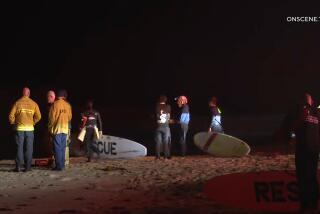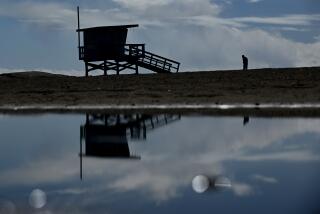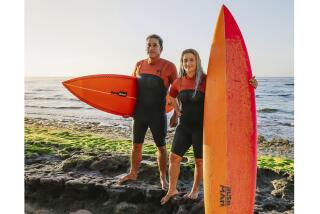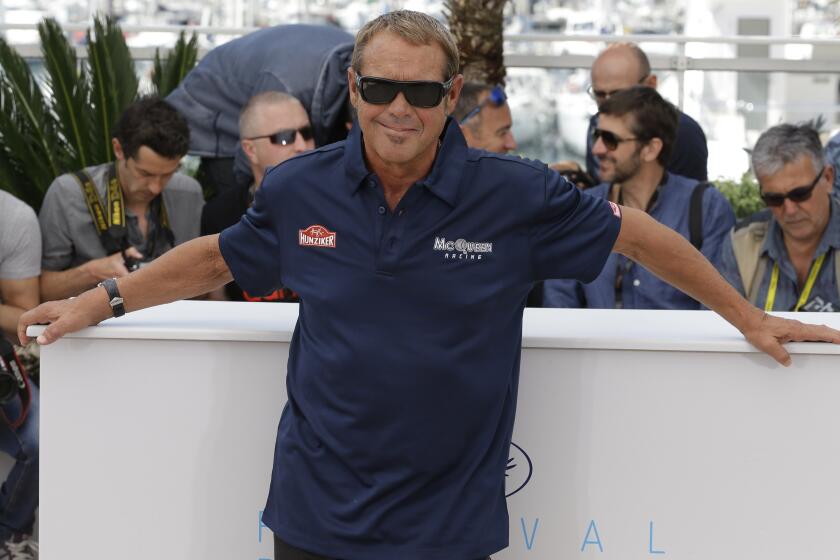Rimmon C. Fay, 78; scientist fought Santa Monica Bay pollution
Rimmon C. Fay, a marine scientist and longtime Venice Beach lifeguard who devoted his life to saving the Santa Monica Bay from pollution and other assaults, has died. He was 78.
Fay died of a heart attack at Berkley West Convalescent Hospital in Santa Monica on Tuesday after a series of strokes that had left him incapacitated in recent years.
A UCLA-trained biochemist and professional diver who collected specimens for biomedical research, Fay focused public attention on industrial discharges of the pesticide DDT off the Palos Verdes peninsula that made fish too toxic to eat and nearly drove the California brown pelican to extinction. He was among the first to call for Los Angeles to halt dumping of sewage sludge, a once-quixotic quest that drew kindred souls in the 1980s who joined with him to launch the movement to clean up coastal waters.
He spent six years as a state coastal commissioner, until complaints to Sacramento leaders about his uncompromising anti-growth attitude and open outrage about damaging coastal wetlands and beachfront got him fired. He was replaced on the panel by a developer.
Admirers often likened Fay to John Steinbeck’s friend and drinking companion, Edward F. Ricketts, a pioneer of marine ecology who inspired the character “Doc” in the novel “Cannery Row.”
“He was so much like Doc Ricketts,” said Dorothy Green, who joined with Fay and others to launch the nonprofit group Heal the Bay. “He earned his living collecting animals for research. He drank too much. He would go out diving at night -- alone.”
Fay supplied sea creatures, aquarium tanks and advice during the production of the 1982 movie of “Cannery Row,” starring Nick Nolte and Debra Winger. His son, Douglas, has a vivid recollection of his beaming father on the movie set: “He was puffing on his cigars. That was one of the best times.”
Fay also spent much of his life, after his divorce in 1975, living and sleeping in his laboratory, located first in Venice, then in Inglewood and Port Hueneme.
Far more comfortable in a wetsuit than a dress shirt and jacket, Fay logged thousands of hours prowling the seafloor doing his own research and collecting specimens.
“He has probably spent more time underwater than any man on the planet,” said Harold Dunnigan, a former Navy diver and retired Los Angeles County lifeguard who taught Fay how to dive in 1955. Dunnigan said he could easily out-compete Fay in swimming contests, but underwater, few could keep up with him. “He was at one with the ocean.”
Over a span of 40 years, Fay made four to six dives a day, mostly collecting live sea animals for his business, Pacific Bio-Marine Labs. He would whisk the animals to meet planes departing nearby Los Angeles International Airport to biomedical researchers at universities worldwide.
His live specimens were used to study human nerve cell damage as well as to develop weapons against tumors and to concoct a non-addictive pain reliever.
Fay supplied sea hares, Aplysia californica, to Columbia University neuroscientist Eric Kandel, who shared the 2000 Nobel Prize for research on the physiological basis of memory storage in neurons, said Janet Fay, his ex-wife, who lives in Salinas, Calif.
Fay celebrated the contributions his marine creatures made to mankind, but often lamented the disservice that man had done in return to sea life and undersea habitat.
“They’ve dumped everything in this bay except radioactive waste,” he once complained to a Times reporter.
Although he saw some improvement in recent years, Fay was disappointed at the long-term trends that had transformed Southern California waters from a major fishing area into an industrial dump.
He talked about the burden of knowing how the bay looked more than 40 years ago, and how it appears today.
“You spent your whole life around the ocean, you develop a sense of responsibility to the environment. If you don’t respond to your convictions, then what kind of person are you?”
Born July 22, 1929, in Santa Monica and raised in Venice, Fay remembered his father, a recreational fisherman, reeling up barn-door-sized halibut from the bay at a time when boys wading into the surf at Venice Beach could still see both their feet and darting fish.
Fay put himself through graduate school at UCLA in the mid-1950s by working as a lifeguard, a part-time occupation that he continued until 2001. He also paid for schooling by collecting sea urchins and other critters for researchers at UCLA, where he earned a doctorate in biochemistry in 1961, and later for colleagues at USC, where he did postdoctoral studies in chemical oceanography.
Dunnigan helped Fay launch Pacific Bio-Marine, but remembers his friend as driven and demanding, willing to work impossibly long hours. Once the engine of their skiff broke down as they left Catalina’s Avalon Harbor. Fay insisted that they row back to the mainland.
“We rowed from 4 p.m. and got in at San Pedro at 2 a.m. and then we had to unload the boat,” Dunnigan said. Fay burned out assistants quickly, and often worked alone.
Fay and other marine scientists over the years noticed a retreat of Southern California’s kelp forests and depletion of various types of fish and shellfish. They debated the reasons for the declines, ranging from poisoning, smothering by sediment, loss of coastal habitat to development, or excessive fishing and harvesting.
When government scientists found extraordinarily high levels of DDT in fish near Palos Verdes, they leaked the documents to Fay, who brought them to The Times and other media outlets, said Craig Barilotti, a marine ecologist who worked with Fay over the years.
The public splash was the first step in a campaign that eventually ended the dumping of DDT by Montrose Chemical Corp. in Torrance into the county sewer lines that discharged into the ocean near Palos Verdes.
Fay helped draft the California Coastal Plan, which was the basis for the law that governs the California Coastal Commission. “He was a rigorous, cantankerous guy who brought great scientific knowledge and integrity to the table, and I loved him for it,” said Peter Douglas, the commission’s executive director.
Over the years, Fay pointed an accusatory finger at Los Angeles for poor sewage treatment and at Southern California Edison’s nuclear power plants at San Onofre and other industrial dischargers that were, as he saw it, choking sea life with pollutants.
“He was always breaking new ground, pointing out new problems,” Barilotti said.
Fay often showed up to testify before public hearings carrying fish covered in tumors or toting other evidence from his underwater surveys.
“He was a whistle-blower,” Barilotti said. “You make a lot of political enemies that way, and a lot of developers and others tried to discredit him. To myself and a lot of other people, Rim was an inspiration.”
Los Angeles County lifeguards are planning a public memorial at the Venice Beach breakwater. No date or time has been set. His four sons are planning to sprinkle the ashes of his cremated remains into the waters of the bay he loved.
Besides his ex-wife Janet and son Douglas, of Marina del Rey, he is survived by three other sons, Rimmon B. Fay of Inglewood, Wesley Fay of Everett, Wash., and Trevor Fay of Monterey, Calif., as well as eight grandchildren.
More to Read
Start your day right
Sign up for Essential California for the L.A. Times biggest news, features and recommendations in your inbox six days a week.
You may occasionally receive promotional content from the Los Angeles Times.






